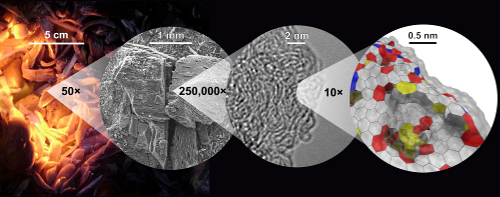Technical Report 219, c4e-Preprint Series, Cambridge
Nanostructure of Gasification Charcoal (Biochar)
Reference: Technical Report 219, c4e-Preprint Series, Cambridge, 2019
- Gasification charcoal (biochar) was analysed using high resolution mass spectrometry revealing no magic number fullerenes i.e. C60 or C70.
- Heated fullerene arc-carbon also lacked magic number fullerenes but contained oxygenated fragments matching that of charcoal indicating a shared fulleroid-like nanostructure.
- Raman spectroscopy and high resolution transmission electron microscopy supported a stacked, fulleroid-like nanostructure.
 In this work, we investigate the molecular composition and nanostructure of gasification charcoal (biochar) by comparing it with heat-treated fullerene arc-soot. Using ultrahigh resolution Fourier transform ion-cyclotron resonance and laser desorption ionisation time of flight mass spectrometry, Raman spectroscopy and high resolution transmission electron microscopy we analysed charcoal of low tar content obtained from gasification. Mass spectrometry revealed no magic number fullerenes such as C60 or C70 in the charcoal. The positive molecular ion m/z 701, previously considered a graphitic part of the nanostructure, was found to be a breakdown product of pyrolysis and not part of the nanostructure. A higher mass distribution of ions similar to that found in thermally treated fullerene soot indicates that they share a nanostructure. Recent insights into the formation of all carbon fullerenes reveals that conditions in charcoal formation are not optimal for fullerenes to form, but instead curved carbon structures coalesce into fulleroid-like structures. Microscopy and spectroscopy support such a stacked, fulleroid-like nanostructure, which was explored using reactive molecular dynamics simulations.
In this work, we investigate the molecular composition and nanostructure of gasification charcoal (biochar) by comparing it with heat-treated fullerene arc-soot. Using ultrahigh resolution Fourier transform ion-cyclotron resonance and laser desorption ionisation time of flight mass spectrometry, Raman spectroscopy and high resolution transmission electron microscopy we analysed charcoal of low tar content obtained from gasification. Mass spectrometry revealed no magic number fullerenes such as C60 or C70 in the charcoal. The positive molecular ion m/z 701, previously considered a graphitic part of the nanostructure, was found to be a breakdown product of pyrolysis and not part of the nanostructure. A higher mass distribution of ions similar to that found in thermally treated fullerene soot indicates that they share a nanostructure. Recent insights into the formation of all carbon fullerenes reveals that conditions in charcoal formation are not optimal for fullerenes to form, but instead curved carbon structures coalesce into fulleroid-like structures. Microscopy and spectroscopy support such a stacked, fulleroid-like nanostructure, which was explored using reactive molecular dynamics simulations.
Material from this preprint has been published in Environmental Science and Technology.
PDF (11.3 MB)



